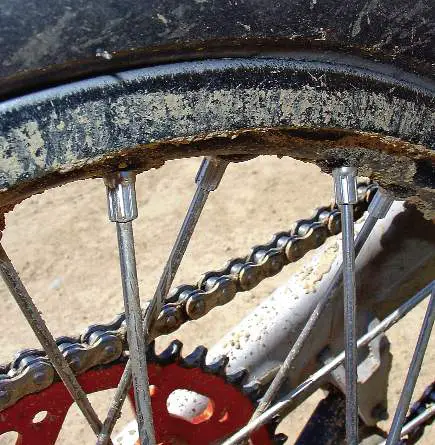LIVING WITH… THE SHERLOCK HOLMES NATURE OF RIM SCRUB

Why isn’t there any mud on the top edge of the rim? The answer to that question is a valuable tuning tool.
If Sherlock Holmes had been a factory mechanic, he would have been able to diagnose what his bike and rider needed just by looking for clues. You can do the same thing by taking a close look at the rim on your bike after a moto. Inspect your rim right beneath the tire bead. See anything? Look again! Look closely and you will see that the bead of the tire has rubbed against the edge of the rim and cleaned a thin strip around the aluminum rim. This is called “rim scrub,” and it is caused by the tire’s lower sidewall folding over the top of the rim flange under compression. Rim scrub is an easy way to calculate how much sidewall flex your tire has. It can be used to tell if you have too little or too much air in your tire. Additionally, excessive rim scrub can also occur if the tire sidewall casing structure is too soft. The goal is to find a balance between tire stiffness and tire air pressure.
TIRE TIPS, TRICKS & CLUES
Chunking: The obvious signs of too much air pressure are a lack of traction, harsh ride quality, and excessive tire deflection on bumps or ruts. Knob chunking can also be a sign of too much air pressure, since too much air pressure limits the tire casing’s ability to flex, which puts more force on the base of the knobs themselves.
Flex: The obvious signs of low air pressure are rim damage or heavy flex markings?or even cracking in the tire sidewall. You may also see excessive flex marks at the base of the knobs due to the soft tire casing allowing the knobs to bend at the base under force.
Heavy-duty tubes: You can generally run 1 to 1.5 psi lower tire pressure with heavy-duty tubes. The thicker tube’s rubber adds to the stiffness of the tire casing. The thicker sidewall effect also makes the tire much less susceptible to pinch flats.
The ballpark number: Average rim scrub should be between 3 and 5mm. Keep in mind that there is a balance between the tire pressure and tire-casing structure. Different makes and models of tires will require different air pressure to achieve the optimum traction, feel and rim scrub.
Rim and tire shape: The shape of the tire bead area and how it physically fits the rim flange will also affect rim scrub, as does the shape of the rim. Tires that have bead savers or large lips in the lower sidewall area mold more or less around the rim flange when the tire casing flexes over. Tires like this will scrub the rim less than 3mm or more than 5mm. The popular Excel rim has a flatter shape than a DID rim. A tire on an Excel rim scrubs a wider band, because the sidewall folds more sharply over the edge of the flange.
Common sense: Rim scrub is very much like a clue at a crime scene. Take note of how much rim scrub you have at different tire pressures, and then compare it to how the tire performs. Once you learn the connection, you can fine-tune your tire’s performance at a glance.
WHO FIRST FOUND RIM SCRUB?
Longtime motocross tire specialist Frank Stacy is responsible for the scientific study of rim scrub. “I personally started studying rim scrub in the mid-1980s,” says Frank. “I was employed by Dunlop and was testing with Team Honda. Ricky Johnson, mechanic Brian Lunnis and I were testing prototype front tires. Out on the track, Ricky was having issues with lack of feel under hard cornering and holding his line. I noticed that each time Ricky came in to change to the next tire, his rim edges were completely cleaned off. As much as 10mm of his rim had been polished clean by the sidewall. I also noticed that the lower sidewall of the tire was polished where it was touching the rim.
“It was then that a light bulb went on and I began to study the effects of rim scrub. We had similar issues when first developing 19-inch rear tires in the late 1980s. The tires scrubbed the flange like crazy, and the shorter sidewalls of the 19-inch tires folded over so much it damaged the rim. We began running higher air pressure, but got to a point where the wheels began to bounce too much and lost too much traction. The only option for Dunlop was to improve sidewall stiffness, which then allowed us to run the lower air pressure we needed for good traction.”




Comments are closed.